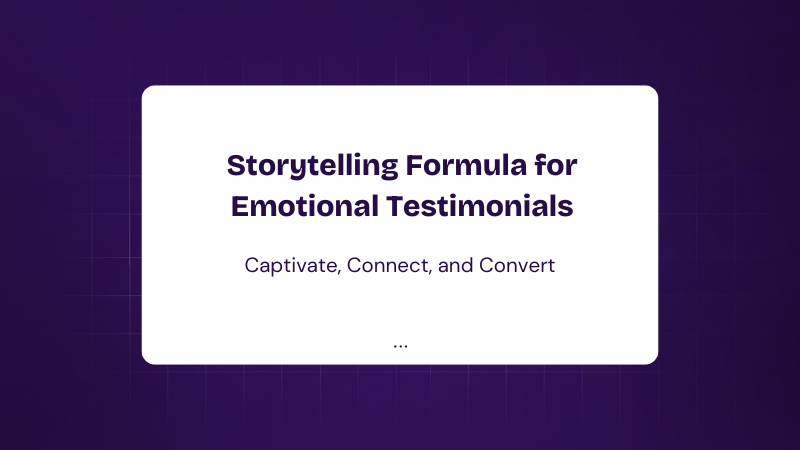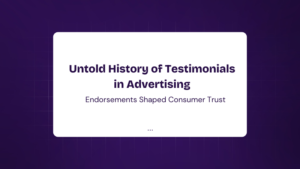Why Your Testimonials Are Boring (and How to Fix Them)
Let’s be honest—most testimonials sound like they were written by a robot that just discovered adjectives.
“Great product. Fast shipping. Highly recommended.”
Exciting, right? Not exactly.
The problem? These testimonials lack emotion, depth, and—most importantly—a story. But when done right, emotional testimonials don’t just sound good; they create a visceral connection with the audience. They tap into deep-seated emotions, human experiences, and psychological triggers that make people take action.
This is where storytelling comes in.
In this guide, we’re diving deep into the storytelling formula for emotional testimonials—the exact framework that turns bland, forgettable reviews into compelling narratives that build trust, create relatability, and drive conversions.
And if you’re thinking, “But I’m not a storyteller!”—don’t worry. By the time you’re done reading, you’ll have a step-by-step blueprint to craft testimonials that don’t just inform but inspire.
Let’s start with the most fundamental question: Why do stories matter in testimonials?
Why Storytelling is the Secret Sauce of Powerful Testimonials
Every great story—whether it’s a Hollywood blockbuster or a childhood bedtime tale—follows a structure that keeps the audience engaged. The same applies to testimonials.
Here’s why storytelling makes testimonials exponentially more effective:
- Emotional Connection: Studies show that emotions drive purchasing decisions more than logic. According to Harvard professor Gerald Zaltman, 95% of purchase decisions are subconscious and emotionally driven. A well-crafted testimonial taps into these emotions.
- Trust & Credibility: People trust real experiences more than generic praise. A testimonial with a story makes it believable and relatable.
- Memorability: Facts are forgotten, but stories stick. Cognitive psychologist Jerome Bruner found that people are 22 times more likely to remember a story than a fact.
- Influence & Persuasion: Robert Cialdini, the author of Influence: The Psychology of Persuasion, emphasizes social proof as a key persuasion factor. A good story makes testimonials more influential.
So, how do you craft a testimonial that doesn’t just say, “Great product!” but instead tells a gripping story that sells?
Enter the storytelling formula for emotional testimonials.
The Perfect Storytelling Formula for Emotional Testimonials
There’s a simple yet powerful formula that makes testimonials resonate:
The HERO Formula
(Hook, Emotion, Resolution, Outcome)
- H – Hook (Set the Stage)
- Start with a problem, struggle, or frustration the customer faced before discovering the product/service.
- The goal is to immediately grab attention and build relatability.
- E – Emotion (Describe the Pain & Struggle)
- Dive into the emotional state of the customer—were they frustrated, stressed, hopeless?
- Make it personal and sensory-driven (What did they feel? What was at stake?).
- R – Resolution (How the Product/Service Helped)
- Introduce the product/service as the turning point in the story.
- Explain how it transformed their situation.
- O – Outcome (The Results & Success Story)
- End with the real, tangible results they experienced.
- Highlight before vs. after differences (stats, emotions, quality of life changes).
Let’s see this formula in action.
Real-Life Example: HERO Formula in Action
Instead of a bland testimonial like this:
“I used this course, and it helped me get clients. Highly recommended!”
We apply the HERO formula:
Hook: “I was on the verge of quitting my freelance career. No clients. No leads. Just a pile of rejection emails.”
Emotion: “Every day felt like a losing battle. I spent hours pitching, only to get ghosted. Self-doubt kicked in, and I started believing maybe I just wasn’t good enough.”
Resolution: “That’s when I discovered this course. I applied the strategies, refined my pitch, and within a month, I landed my first high-paying client!”
Outcome: “Fast forward six months, and I’m now fully booked with clients, making more than I ever imagined. This course didn’t just teach me skills—it gave me confidence and a clear roadmap to success.”
See the difference?
Instead of just telling, this testimonial shows the transformation in a way that emotionally connects with the audience.
Psychological Triggers That Make Testimonials Even More Powerful
Want to take your testimonials to the next level? Use these psychological triggers:
- Specificity – Numbers, timeframes, and concrete details make testimonials more believable. (e.g., “I lost 15 lbs in 3 months” > “I lost weight.”)
- Sensory Language – Help people visualize the story. (e.g., “I woke up every morning dreading work” > “I didn’t like my job.”)
- Relatability – The testimonial should reflect the struggles of your ideal audience.
- Transformation – Focus on how the product/service changed their life, not just solved a problem.
- Authenticity – Avoid overly scripted testimonials. A bit of imperfection makes it real.
How to Collect Emotional Testimonials from Customers
Most customers won’t naturally tell a compelling story in their testimonials—you have to guide them.
Questions to Ask for Story-Driven Testimonials
Instead of asking, “Can you leave us a review?”, try these:
- Before Using Our Product/Service:
- What problem were you facing before finding us?
- How did that problem make you feel?
- During the Experience:
- What made you decide to try our product/service?
- What was your first impression?
- After the Transformation:
- What specific results have you seen since using our product/service?
- How has your life/business changed?
When customers answer these, you’ll get stories, not statements.
FAQs
How long should an emotional testimonial be?
Ideally, 100-300 words—long enough to tell a compelling story but concise enough to keep attention.
Can I edit testimonials to fit the storytelling formula?
Yes, but keep the authentic voice intact. Restructure the wording if needed but don’t change the essence.
Do video testimonials follow the same formula?
Absolutely! In fact, video testimonials using the HERO formula are even more powerful since they capture tone, facial expressions, and authenticity.
What’s the best way to ask for a testimonial?
Instead of “Can you leave us a review?”, ask story-driven questions like:
“What problem were you facing before using our product? How did it change your life?”
Can I use storytelling for B2B testimonials?
Yes! Businesses relate to challenges, solutions, and results just like individuals. Highlight pain points and measurable outcomes.
What if a customer gives a boring testimonial?
Follow up! Ask for specifics—”Can you describe what changed for you?” This often unlocks deeper insights.
Now, go transform those boring testimonials into stories that sell!
Your Testimonials Can Sell for You—If You Tell the Right Story
A great testimonial is not just a review; it’s a mini success story.
By using the HERO formula, you turn simple words into powerful narratives that inspire, connect, and convert.
And the best part? When done right, your customers will sell for you—without you having to do the hard work.
So, next time you collect a testimonial, don’t just settle for “Great service!”—dig deeper, uncover the story, and watch your conversions skyrocket.
Now go out there and start crafting emotional testimonials that sell.



